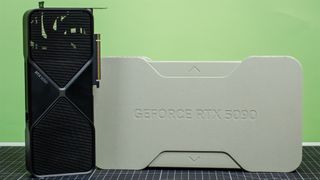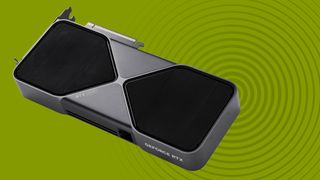Refresh
I found it interesting to check Steam’s Hardware Survey and see that of all participating players in December 2024, 19.56% game at 1440p on their main monitor.
2K is the sweet spot between visual fidelity and performance strain, so it makes sense that a sizable chunk of Steam players hang out at this resolution. The 5090 absolutely crushes most titles at 1440p and high settings, though it does underperform compared to some of its predecessors in certain situations.
If you haven’t already checked out Newegg’s RTX 5090 stock, do give it a look. It’s running an interesting deal on GPU trade-ins right now, meaning you can clean out your old GPU and upgrade to the 5090 in one go.
Just for fun to see how much I’d get, I plugged my GeForce RTX 3080 Ti Gaming X Trio 12G in and found Newegg would pay me $419 towards a new graphics card. That’s a 20% discount on the 5090’x $1,999 price tag – not bad at all.

The RTX 5090 is the first graphics card on the market to feature GDDR7 video memory (32GB of it at that), and when combined with the improvements to DLSS, as well as Tensor and Ray Tracing Cores, it’s positioned as the first GPU viable of capably running games at 8K resolution.
Our Managing Editor, Core Tech Matt Hanson took the 5090 for a spin in graphically-demanding titles like Cyberpunk 2077, Hogwarts Legacy, and Star Wars: Outlaws to test exactly this, and the results are pretty amazing. The 5090 was able to handle Cyberpunk 2077 at 8K (7,680 x 4,320) resolution, with graphics set to RT Over Drive (essentially the highest they can go), at 148.89 frames per second.
With our Nvidia RTX 5090 review live and its benches marked, we finally have some numbers to share with the more quantitatively inclined. The graphs below show how the new RTX 5090 stacks up against cards like the RTX 4090 and 4080, as well as the RX 7900 XTX and 7900XT on AMD’s side.
Yes, there’s a boost where DLSS is considered; but there’s also a markable upgrade over the previous generation without upscaling in the frame. As per our 5090 review, “With ray tracing and no upscaling, the difference is even more pronounced with the RTX 5090 getting just over 34% faster average framerates compared to the RTX 4090 (with a more modest 7% faster average minimum/1% fps).”
These are some exciting performance bumps, and I have a feeling the 5000 series will fly off the shelves particularly quickly.
When it comes to availability, I’ve done my best to provide a breakdown of the key retailers to watch out for higher up in this article, but be aware that stock is extremely likely to all but evaporate on launch day. Some sites, including Best Buy, Scan, and Nvidia’s own site are offering a ‘Notify Me’ feature which can alert you via email or text message when stock drops on January 30.
It’s worth bearing in mind, however, that Nvidia’s own site will often redirect shoppers to other retailers, especially if you’re looking to buy a third-party version of the RTX 5090, so it’s a good idea to keep tabs on actual seller sites instead.
The real question for any shoppers out there is whether or not they should spring for the RTX 5090, or its little sibling the RTX 5080 – after all, the 5080 is quite literally half the price of the 5090 at $999 / £979 compared to the 5090’s $1,999 / £1,939 price tag.
Although we haven’t quite finished our testing with the cheaper (imagine me doing air quotes around that particular word) GPU, it’s fair to say that the 5080 won’t offer a pure half of the performance available on the 5090, especially once DLSS 4 and Multi Frame Generation are factored in. Of course, the RTX 5090 will likely be the more future-proofed choice, and it does carry with it certain bragging rights…
If you’re currently rocking an RTX 3000 GPU in your rig and have been contemplating an upgrade once the next-gen cards drop (well, why else would you be here?) – you might want to know that Nvidia is potentially planning some retroactive upgrades to your GPU.
Nvidia VP Bryan Catanzaro recently suggested that it might be possible to bring Frame Generation to RTX 3000 cards, as the new version of Team Green’s frame-gen tech doesn’t rely on the Optical Flow hardware accelerator that enabled the tool in the RTX 4000 generation. Instead, it uses an AI-based solution, something that RTX 3000 cards – with their AI-capable Tensor Cores – could potentially utilize. In order words, that cutting-edge technology might soon be available for users with older GPUs, potentially nixing the need for an immediate upgrade.
Some of you might be sitting there wondering about DLSS 4 and its fancy new Multi Frame Generation tech (the latter of which will be exclusive to RTX 5000 GPUs). The viability of DLSS and other upscaling tools of its ilk has been hotly contested by some sectors of the PC gaming community, some of whom claim that it’s become a crutch – an excuse for Nvidia to dial back generational hardware improvements and for game developers to cheap out on PC optimization.
But if recently released usage data is accurate (and there’s frankly no reason to believe it’s not), it looks like DLSS is here to stay. Thankfully, the new DLSS 4 will be backward compatible with all RTX GPUs back to the 2000 generation – unlike DLSS 3, which was locked to RTX 4000 cards exclusively.

Our Nvidia GeForce RTX 5090 review is now live! Our components editor, John Loeffler, gave it 4.5 stars, calling it “the supercar of graphics cards”. He did knock it a bit for its “obscene” power consumption, which exceeded 550W in his testing, but praised its redesigned cooling and slimmer form factor.
Overall, it’s a major step up from the RTX 4090 in terms of performance, even without factoring in DLSS 4, so once that upscaling tech rolls out on launch day, you can expect even better performance.
The new, sleeker RTX 5000 design reportedly almost didn’t happen: earlier this week, we spotted a mysterious possible RTX 5090 prototype that was a seriously beefy boy, packing specs beyond the real 5090 and a truly absurd 800W power requirement.
While that prototype remains shrouded in uncertainty, it’s possible that it might rear its head further down the line if Nvidia chooses to resurrect its long-dormant Titan RTX series for professional users.
If you’ve somehow stumbled onto the wrong page and were actually looking for Nvidia’s more affordable (but still definitively high-end) new GPU, you can check out our where to buy the RTX 5080 guide instead. I’ll be making sure both pages stay updated regularly up to launch day and beyond to help you track down stock, and it’s worth bearing in mind that the RTX 5080 might be a little easy to get hold of than the flagship 5090 – so if you’re desperate for shiny new graphics card, that could be a better bet.
Fun fact: the RTX 5090 is going to be quite a bit smaller than its predecessor the RTX 4090, despite ostensibly being a more powerful card. Yes, I have to say ‘ostensibly’ because we’re not past the review embargo yet, but come on, we all know it’s going to perform better.
I’m personally over the moon that Nvidia has opted to slim things down for this new high-end GPU, because quite frankly the RTX 4090 was a comically oversized beast of a card regardless of which model you bought. All of the Founders Edition models of every upcoming RTX 5000 card will be certified for Nvidia’s own Small Form Factor Ready scheme, meaning lovers of compact PCs and living-room builds can rejoice.
There have been rumors about RTX 5000 stock shortages circling for the past few days, but even if they prove to be untrue, I strongly suspect that we’re going to see an absolute sell-out almost immediately on launch day. With no pre-orders in sight to secure you a unit in advance, your best bet is likely going to be camping on multiple retailer sites (which I’ve handily organized for you above).
The scalpers are likely to be out in force again for this launch, even now that crypto-mining isn’t as widespread and prevalent as it was during previous GPU releases. The RTX 4090 never really got over its stock issues, with units still selling above MSRP on sites like Amazon. However, that was arguably down to how much of a letdown the RTX 4080 was – hopefully this time around, Nvidia will get things right with its new not-quite-flagship GPU.
Although you’ll still have to wait a few hours until we’re allowed to publish our review – we really don’t want to hear from Nvidia’s legal team today! – you can check out our RTX 5090 unboxing right now to get an early sneak peek at the contents of the package.
A new type of power adapter is now included in the box, making it easier to install the GPU inside smaller PC cases and hopefully putting to bed any previous thorny issues with melting power connectors…

Here we go again, folks… Nvidia is about to drop its new next-gen flagship graphics card, the RTX 5090 (as well as its little brother the RTX 5080), and you can bet that hordes of gamers – and scalpers – will be chomping at the bit to get their hands on one.
As someone who’s currently got an RTX 4080 sitting inside my home PC, I’m feeling rather comfortable this time around – not beset with the urgent need to upgrade that I felt during the last big Nvidia launch. But that doesn’t mean I’m not here to help you out: with the January 30 release date closing in and the review embargo lifting today, January 23, I’ll be here for the next few weeks to keep tabs on stock and (hopefully!) point you in the right direction.
You’ll be able to check out our review later today, but right here I’ve compiled all the retailers you’ll want to keep an eye on when it comes to tracking down one of these highly-coveted GPUs. Some storefronts, such as Newegg, already have dedicated landing pages for the RTX 5090, but nowhere seems to be offering any sort of pre-orders yet – it’s possible they won’t at all. However, some retailers – including Nvidia itself – are allowing shoppers to sign up for email notifications.
Be sure to bookmark this page and check back for more updates – I’ll be keeping a close watch on retailers for any updates as stock shifts, so you can be the first to know.



























You must be logged in to post a comment Login